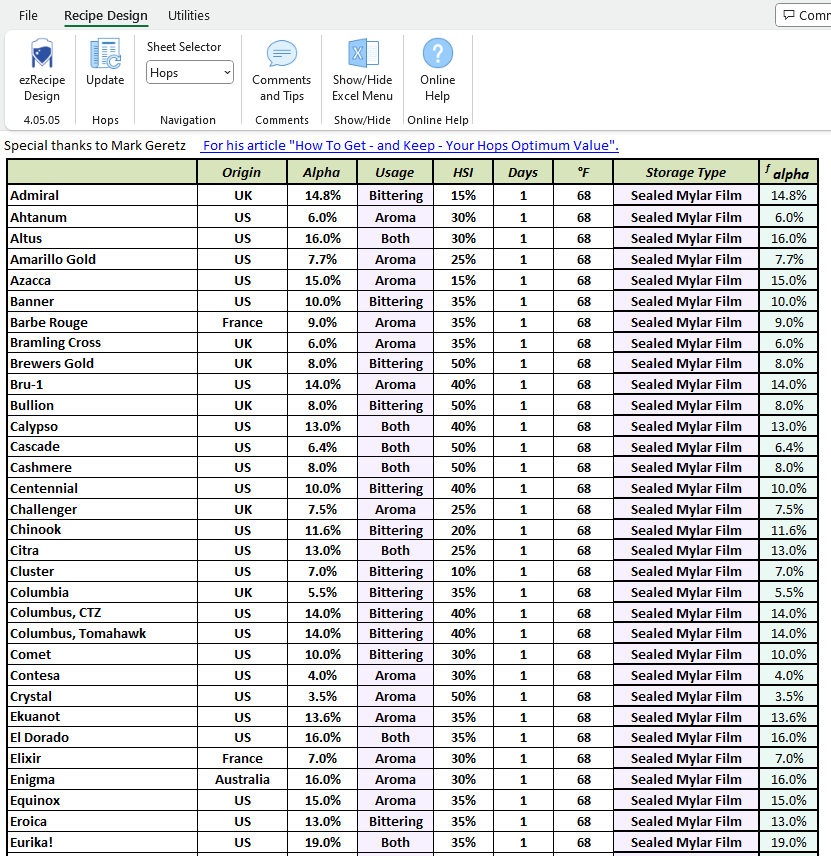Brewhouse and Mash Settings
Before designing your first recipe, it is essential that you first determine the capacities of your brewing system. Doing so will assure you that your recipes' grain, water, wort, and hop additions will not overwhelm the brewing system. You start by entering the maximum volumes of your Mash Lauter Tun, Boil Kettle, and Fermentation vessels. When using a single vessel brewing system, there is no need to enter Boil Kettle capacity as both mash and boil occur in the same place.
Next, you should enter losses due to evaporation in the boil, grain absorption in the mash, and wort losses in hoses, pumps, and dead space. Your accuracy when entering this information will later reward you with the best brewing system efficiency calculations.
Select the type of mash to be used, either batch or lauter, then enter your preferred minimum mash thickness, which can typically be a value between (1.25 Qt/Lb - 2.61 L/Kg) to (2.50 Qt/Lb - 5.22 L/Kg). Next, enter the volume of beer required to go into bottles, casks, or kegs and fermenter trub and hop absorption loss. Congratulations, you have now entered all of the brewhouse information for your brewing system!
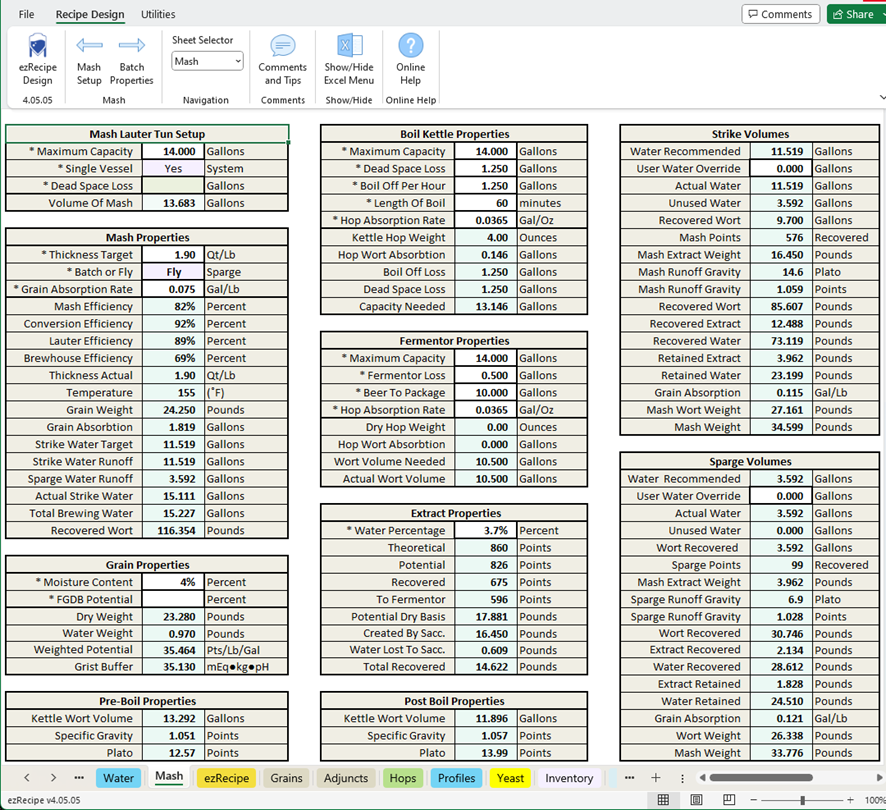
The final two settings needed to complete the setup are estimated mash efficiency and mash temperature, both are entered on the ezRecipe page.
To accurately predict the amount of brewing water needed and the potential amount of sugar extracted from the recipe's grains. Based on most typical base malts, use the default values of 4% for moisture content, 3.7% for water extracted from grain, and 80% for the grain 'fine grind dry basis' percentage. Congratulations, you have entered all the mash information for your first recipe!
Strike Volumes and ezRecipe Settings
The example recipes use the default values for acid concentrations, calcium chloride density, gravity calculation, and grain crush. The values entered are saved as part of each recipe and used when reopening the recipe.
Grain crush values range from coarse 50% to pulverized (FGDB) 100%. Most homebrewers should select a crush between 60% to 70%, with 65% being the average for home brewing. There is a correlation between grain crush and mash efficiency, where a finer crush will improve mash efficiency. The type of brewing system used will determine how fine the grain crush can be.
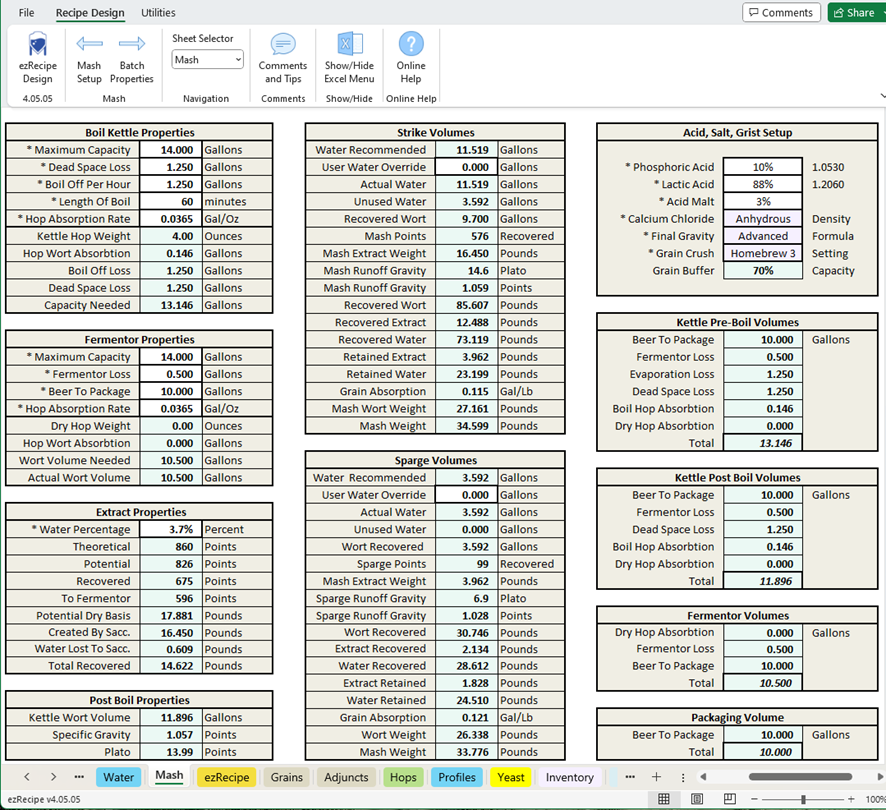
Brewing Water Properties and Dillution
This section is for brewers focused on brewing water and the influence it has on their beer. The conversion of starches to sugars is optimal within a mash ph range of 5.2 to 5.6. Light-colored grains tend to have a natural pH of 5.7 to 5.8 in the mash, while most municipal water sources have a pH range of 6.5 to 8.5. Mashing light-colored grains in untreated municipal water makes it impossible for the mash to be in the optimal 5.2 to 5.6 pH range.
A water report from your local water supplier will list its mineral properties, alkalinity, and pH level. And as seasonal variations may occur in your water supply, subsequent water reports are often necessary. Enter the values listed in your most recent water report as your Source Water.
Advanced homebrewers use distilled or reverse osmosis water as a basis for building their custom brewing water profiles.
It contains little to any salts, minerals, or alkalinity. It is ideal for diluting your source water and reducing its mineral content. You can adjust the alkalinity of your source water by blending it as needed with a percentage of dilution water. Then select your recipe grains, adjusting minerals or acid to keep the mash pH in the 5.2 to 5.6 range.

Sparge Water Properties and Mineralization
Sparge water adjustments can range from simple to somewhat complicated. For example, some brewers prefer to adjust their mash strike water and sparge water using salts, minerals, and acid as needed to maintain a target pH value. In contrast, others may choose to adjust their strike water using distilled or reverse osmosis water for sparging. Either way is correct, as each method has its own merits.
Since distilled and reverse osmosis water contains insignificant amounts of salts and minerals, it will not change the pH of the wort when used for sparging. Therefore, this approach is ideal for any style of beer where the pH of the wort in the boil kettle can be the same as the mash pH. However, beer styles requiring a kettle pH different from the pH of the wort at the end of the mash will need some adjustments.
When lowering sparge water pH, lighter-colored beer styles often benefit more than darker-colored styles of beer.
Using water that is high in alkalinity would necessitate making some adjustments before using it for sparging. When using high alkalinity water, the goal is to prevent the sparged wort pH from rising above 5.4 to 5.5. Lactic or Phosphoric acid used in small amounts will neutralize alkalinity and keep pH in check without imparting noticeable flavors. Additions of gypsum, sodium, and Epsom salt will lower pH while mineralizing the water to some degree.

Recipe Design with ezRecipe Design
From the BJCP Styles dropdown list, select the style of beer to use as a guide when building your new recipe. Each of the many beer styles displays the minimum and maximum values for color, bitterness, alcohol, and final gravity. The actual values for your recipe's color, IBU, ABV, and final gravity will continue to change as you add ingredients. While it is acceptable to 'color outside the lines', it is also good to stay within the range of values recommended for each beer style.
Select your grains from an extensive list of the most commonly used grains. Then edit the default grain values as needed to match the values of grain you have on hand. For example, if the delivered 2-Row base malt is lighter or darker in color than the grain on hand, you can change the Lovibond value. The parameters you enter will override the default values, and are used in your recipe.
The default values for grains, adjuncts and hops are all editable as needed to match the ingredients you have on hand. The edited values for all ingredients become part of the recipe when saved.

Mash Water
Once you have selected all of the grain used in a recipe and verifying the quantity, color, and extract potential for each grain entered, it is time to focus on the brewing water properties. The mix of ingredient types and amounts is unique to each recipe, just as the brewing water properties to obtain a specific target mash pH.
When correctly matched to a grain bill, brewing water with the correct properties will keep the mash pH within a very narrow range called the recipe's target pH. The target pH typically falls between one of three pH ranges depending on the beer style. A pH of 5.2 to 5.3 is optimal for a crisper beer, a pH of 5.3 to 5.4 is optimal for most light-colored beer, and a pH of 5.4 to 5.5 is optimal for dark-colored beer styles.
In this example we use one hundred percent reverse osmosis dillution water, and zero percent source water for the recipe.
Notice how the properties of the target and mash water profiles are both equal. The mash pH target of 5.38 only uses salt and mineral additions, without any acid. And the automatic salt and acid calculations adjust the mash water profile concentrations the reach the target mash pH value.
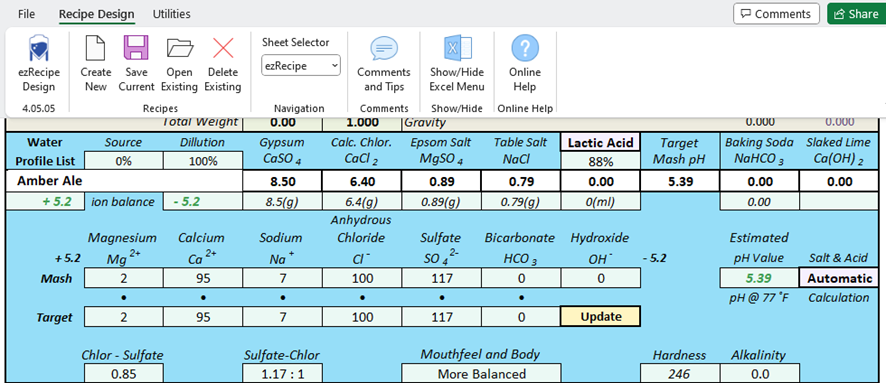
The strike water now contains enough buffering power to maintain the target pH throughout the mash, eliminating the need to use acid. Also, note that the ion balance of this water profile is less than 0.1 ion. An ion imbalance greater than this indicates an error in the water profile's ion concentrations and should be resolved before use.
Water Profiles
Included are more than two dozen brewer-tested water profiles that will get you up to speed in building recipes quickly. Custom-tailored to pair perfectly with a wide range of beer styles ranging from ultra-light Wheat beers to deep dark Porters and Stouts.
Use them as they or use them as a template for creating your custom water profiles to use in your recipes. We carefully crafted each one to maintain ion balance while adjusting the mash to match the optimal pH target.
As your knowledge of water properties and their relationship to grain selection in recipes grows, so will your list of water profiles. There is plenty of capacity for adding hundreds of your favorite water profiles too.

Water profiles appear as Target properties when selected in the Mash Water section. When changing the properties of a water profile, your changes also update the Target properties on the Mash Water section.
Hop Selection and Brewing Properties
We use hops to offset malt sweetness with bitterness and to provide flavor and aroma to beer. When added to beer, their aromas and flavors can range from resiny, floral, and spicy to citrusy and tropical. Your selection of hops will dramatically change the character of any style of beer you brew.
Whether the hops in your beer were grown next door or shipped to you from thousands of miles away, they play an essential role in brewing beer. Knowing how your hops are stored and for how long also makes a difference. When freshly picked, packaged in glass or nitrogen-purged envelopes, and held at room temperature or lower will provide the best quality.
Select the hop varieties you wish to use in your recipe from a list of popular hops. Then enter the weight of the addition, the type, and how to use each addition. You can use the default alpha acid percentage, or since that value tends to vary by crop and supplier, override it with your values.
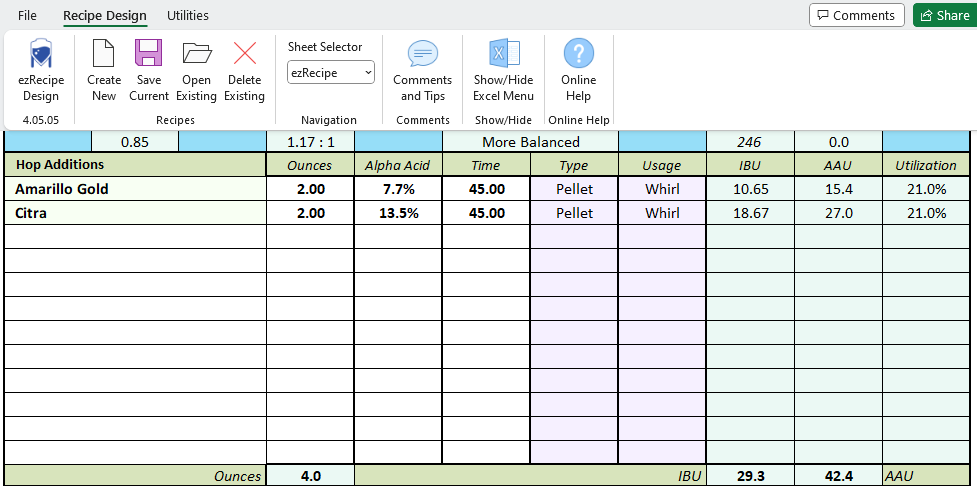
The values you enter are saved with the recipe and will load when reopening the recipe. You can also update the hop varieties with the override values directly. A handy feature when you have a lot of hops on hand with similar values.
Hop Varieties, Properties and Storage
The type of packaging used and the length of time spent in storage significantly impact hop freshness. Under ideal conditions, the hops you use will contain the percentage of alpha acids printed on their packaging. The alpha acid in hops diminishes over time to a point where only a fraction of the original amount remains. The length of time in which this happens differs by hop variety, packaging, and storage conditions.
Under some circumstances, the ten percent alpha acid hops you use for bittering may contain far less than that amount reducing the amount of bittering they add to your recipe.
By manipulating the number of days in storage and the storage temperature for an individual hop on the Hop Varieties section, you will see the percentage of alpha acid remaining.
